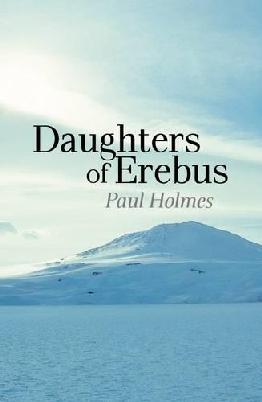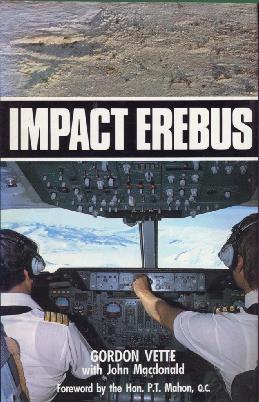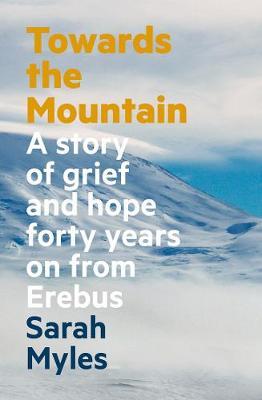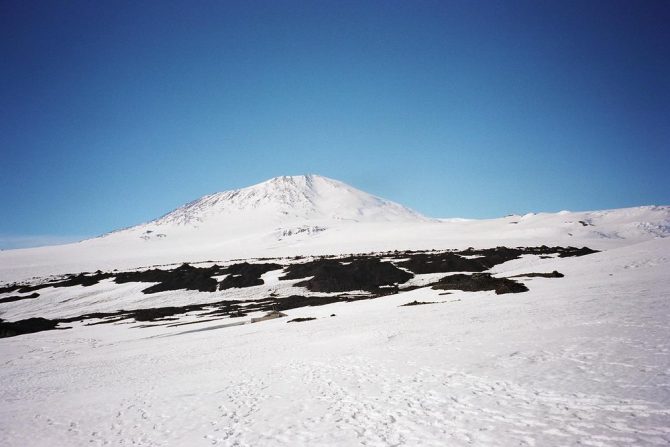On 28 November 1979, Air New Zealand Flight TE901 crashed into the slopes of Mt Erebus in Antarctica while on a sightseeing flight to the continent. All the 237 passengers and 20 crew on board were killed. The crash remains the worst civilian disaster in New Zealand’s history.
- What happened?
- How many died?
- Other events and outcomes
- Search our catalogue
- Erebus information
- More resources about disasters
What happened?
At 8:20 am on 28 November, 1979, Air New Zealand Flight 901 left Auckland Airport. On board were 237 passengers and 20 crew, looking forward to the 11-hour return sightseeing flight to Antarctica. These sightseeing flights had been operating since February 1977, and took the passengers on a low-flying sweep over McMurdo Sound, returning to New Zealand on the same day.
Captain Jim Collins and his co-pilot Greg Cassin had not flown the Antarctic flight before, but the flight was considered to be straightforward and they both were experienced pilots.
Incorrect flight co-ordinates entered in plane's navigation system
 Nineteen days earlier the pilots had attended a briefing session where they were shown the printouts of a flight plan used by previous flights to the Antarctic. The plan gave co-ordinates for the trip to Antarctica and across McMurdo Sound. With these co-ordinates entered into its computerised navigation system, the plane could fly automatically to its destination.
Nineteen days earlier the pilots had attended a briefing session where they were shown the printouts of a flight plan used by previous flights to the Antarctic. The plan gave co-ordinates for the trip to Antarctica and across McMurdo Sound. With these co-ordinates entered into its computerised navigation system, the plane could fly automatically to its destination.
On the morning of 28 November Collins and Cassin entered the series of latitude and longitude co-ordinates into the aircraft computer. However, they did not know that two of the co-ordinates had been changed earlier that morning. When these incorrect co-ordinates were entered into the computer, they changed the flight path of the aircraft 45 kilometres to the east.
Flight 901 given permission to fly low
At 12:30pm Flight 901 was about 70 kilometres from McMurdo Station. Permission was given by the McMurdo radio communications centre to descend to 3050 metres and proceed “visually”.
Air safety regulations were against dropping lower than a height of 1830 metres even under good weather conditions, but Collins believed the plane was flying over low, flat ground. Other pilots regularly flew low over the area to give their passengers a better view.
Flight 901 set on collision course with Mount Erebus
 At 12.45pm Collins advised McMurdo Centre he was dropping further to 610 metres. At this point he locked onto the computerised navigational system, but Flight 901 was not where either McMurdo Centre or the crew thought it was. The change in the two co-ordinates had put Flight 901 on a path not across the flat ground of McMurdo Sound, but across Lewis Sound and towards the 3794 metre-high active volcano, Mount Erebus.
At 12.45pm Collins advised McMurdo Centre he was dropping further to 610 metres. At this point he locked onto the computerised navigational system, but Flight 901 was not where either McMurdo Centre or the crew thought it was. The change in the two co-ordinates had put Flight 901 on a path not across the flat ground of McMurdo Sound, but across Lewis Sound and towards the 3794 metre-high active volcano, Mount Erebus.
Because the air was clear and beneath the cloud layer, the white of the ice blended with the white of the mountain, with no contrast to show the sloping up of the land - a whiteout.
At 12:49pm the deck altitude device began to blare a warning but there was no time for Collins to save the situation from disaster. Six seconds later Flight 901 hit the side of Mount Erebus and disintegrated.
Contact with Flight 901 lost
From 12:50 pm McMurdo Centre kept trying to contact Flight 901, and finally informed Air New Zealand headquarters in Auckland that communication with the aircraft had been lost. US search and rescue aircraft were put on standby.
At 10:00pm (New Zealand time), about thirty minutes after the DC-10 would have used the last of its fuel, the airline told reporters that it had to be assumed that the aircraft was lost. Searches were made over the usual flight path, but nothing was found.
Wreckage located on the side of Mount Erebus
Just before 1:00am (New Zealand time) the crew of a United States Navy plane found some unidentified wreckage on the side of Mount Erebus. There were no signs of survivors. 20 hours after the crash, helicopter search parties were able to land at the site and confirm that the wreckage was the remains of Flight 901. All 257 people on board had died.

How many died?
257 people died (237 passengers and 20 crew).
Other events and outcomes
Recovering the bodies of the victims
The wreckage made a 600-metre trail across the lower slopes of Mount Erebus. As the fuel tanks exploded, a fireball ripped through what was left of the fuselage. The force of the impact would have knocked the passengers out or killed them immediately.
The task of recovering and identifying the bodies of the passengers and crew (200 New Zealanders, 24 Japanese, 22 Americans, 6 British, 2 Canadians, 1 Australian, 1 French, 1 Swiss) was made more difficult because of the numbers involved.
Over 60 people worked on the accident site, most in body recovery. 213 victims were eventually identified. On 22 February 1980 a burial service was held for the 44 unidentified victims.
Investigation into the causes of the crash
No mechanical reason for the accident
Early in the investigation into the causes of the disaster, it became clear that there was no mechanical reason for the crash. The information on the flight recorder tapes showed there had been no emergency in the cockpit of the aircraft.
Attention was then focused on the possibility of pilot error, pointing to the inexperience of the two pilots in flying in the Antarctic.
Chippindale Report blamed pilot error for the crash
A report by the chief inspector of aircraft accidents, Ron Chippindale, came out in May 1980. It stated that the decision of the captain in dropping to a height below the approved level, and continuing at that height when the crew was not sure of the plane’s position, had been the main cause of the accident.
Royal Commission of Inquiry blamed Air New Zealand for the accident
Just weeks before Chippindale’s report came out, the government announced a one-man Royal Commission of Inquiry.
 On 27 April, 1981, Justice Peter Mahon, released his report. This report placed the blame for the accident on the airline systems that had allowed the aircraft to be programmed to fly on the path which led directly to Mount Erebus.
On 27 April, 1981, Justice Peter Mahon, released his report. This report placed the blame for the accident on the airline systems that had allowed the aircraft to be programmed to fly on the path which led directly to Mount Erebus.
Mahon found that Captain Collins had been authorised by McMurdo to descend to 450 metres, and could not be said to have been guilty of unauthorised low flying
. He was also damning of the evidence given by the airline famously calling it "an orchestrated litany of lies".
Air New Zealand and the Civil Aviation Division ordered to pay the costs of the inquiry
Air New Zealand and the Civil Aviation Division were ordered to pay the costs of the inquiry, and the airline had to pay an extra fee of $150,000. The chief executive of Air New Zealand resigned a week after the report was released to the public.
Debate on where the blame for the crash should be placed continued. The changed flight path was in line with Mount Erebus but would have been safe if there had been no drop in height below the recommended level. Later court decisions questioned the way in which Mahon conducted his investigation.
Memorials
A wooden cross was erected above Scott Base to commemorate the disaster. It was replaced in 1986 with an aluminium cross after the original one was eroded by ice and snow.
Before the 30th anniversary of the Erebus crash, Air New Zealand apologised to those affected at a ceremonial unveiling of a memorial sculpture at the airline’s headquarters in Auckland. The sculpture Momentum - was designed by Christchurch artist Phil Price.
In 2010 a koru sculpture, containing letters from the families of those who were lost, was installed next to the cross above Scott Base.
Search our catalogue
-
 Search our catalogue for more about the Mount Erebus disaster
Search our catalogue for more about the Mount Erebus disaster
- Search our catalogue for Erebus-related newspaper articles
Erebus information
- Erebus topic and media gallery
- NZHistory.net.nz brings together a wide range of images and information on the disaster.
- Erebus Flight 901: Litany of lies?
- Explore the podcast, video, photos and map from the New Zealand Herald.
- The Erebus story
- A comprehensive site with audio-visual footage, photographs, personal accounts and detailed historical information as well as a school section for students and teachers. Maintained by the New Zealand Air Line Pilots Association.
- Remembering Erebus
- A set of images on DigitalNZ.
- TVNZ Erebus coverage
- Video, archival footage, news reports and photo galleries.
- Sound Archives
- Radio New Zealand archive audio including original reports phoned in from the ice.
- White Silence
- A Stuff/RNZ podcast about the Erebus Disaster.
More resources about disasters
- Go to our page on New Zealand disasters
- Read some children's non-fiction books about disasters
- Read some adult non-fiction books about disasters
- Read some stories about New Zealand kids in disasters



